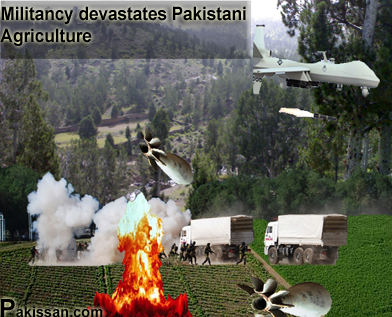Militancy devastates Pakistani
agriculture
By Ashfaq Yusufzai
 Life
for Sanaullah Shah was never as hard as it has been for the
past few years.
Life
for Sanaullah Shah was never as hard as it has been for the
past few years.
I have 100 acres of
fertile land that can grow all sorts of crops, but the wave
of militancy has turned our field to barren land," the
52-year-old South Waziristan resident told.
Like other farmers in the
Federally Administered Tribal Areas (FATA), he used to earn
a decent income yearly, but the militancy that took off in
2007 has slowly but regularly sapped his livelihood.
"I know at least 50
land-owning families who have become so poor that they don't
have enough food for their own use," he said. "About five
years ago, the farmers were well off."
Impact on economy,
citizens:
Agriculture accounted for 25.9% of Pakistan's GDP in
1999-2000, but its share dwindled to 21.3% in 2009-2010,
according to the 2012 Economic Survey of Pakistan.
Neglect of irrigation systems has forced FATA farmers to
growing farming cereal crops, it said. Before the militancy
surged in 2007, 65% of the FATA population worked in
agriculture, the survey said. Today, after all the
disruptions, only 40% do.
"[Besides other aspects of agriculture], the orchards in
North and South Waziristan that produced high-quality plums,
pine kernels, apricots, pears, peaches and pomegranates have
been badly affected by the endless wave of militancy,"
Muhammad Shakoor, a field assistant at the FATA Agriculture
and Livestock Department, said.
Militants habitually cut
power lines in the tribal areas, he said, adding that such
sabotage has brought farming in Kurram, Khyber, Bajaur and
Orakzai agencies to a standstill.
"In 2000, about 35% of households lived below the poverty
line in FATA, which reached 66% in 2011," Shakoor said.
"We used to grow wheat, vegetables and fruits for the other
parts of the country, but now everything is in shambles,"
Khyber Agency resident Muhammad Gul said. "Now we don't have
enough food for own personal use, let alone for commerce."
Likewise, farmers in Waziristan, who are respected for
breeding sheep and producing high-quality wheat and maize,
have been on the receiving end of the violence.
Fear of the Taliban has discouraged agricultural consultants
from venturing out even to peaceful areas of FATA, South
Waziristan resident Saleh Muhammad said.
Kurram Agency farmers suffered, as did their counterparts
elsewhere in FATA. "We earned Rs. 5m (US $46,000) [yearly in
2005] from a variety of apples known for their flavour and
sweetness," Parachinar-based farmer Shaiq Hussain said. "Our
income dropped to a meagre Rs. 500,000 (US $4,600) [in
2011]."
"Farmers faced problems in transporting their goods to
markets due to closure of roads," he said. "Last year, the
people [of Kurram] lost more than Rs. 250m (US $2.3m)."
FATA taking steps:
To help farmers recover from those challenges, authorities
in FATA have launched numerous programmes to strengthen
agriculture.
"We are preparing the farmers to increase their output by
employing modern techniques," an official of the FATA
Department of Agriculture Extension, said.
The programme focuses on land reclamation, training farmers
in off-season vegetable and mushroom cultivation and
establishing farm service centres to boost their yield, he
said.
"We are establishing tea plantations in Orakzai, Kurram,
Bajaur and South Waziristan agencies where 50,000 plants
would be cultivated every year," he said.
Results in the tea plantations indicate a bright future for
that crop, he said.
FATA vs. Malakand:
Farmers in Malakand Division, in adjoining Khyber
Pakhtunkhwa Province, who suffered from the militancy
between 2007 and 2009, are also back in business.
A 2012 survey by the National Agricultural Research Centre (NARC)
showed that nearly 48% of Pakistan's total fruit is produced
in KP – with Swat District being a major contributor with
25%, which decreased to 10% when the Taliban ruled Malakand
Division from 2007 to 2009, Murad Shah, secretary of the
Malakand Farmers' Association, said.
An estimated 55% to 70% of the fruit grown in Malakand went
to waste during the era of Taliban shelling and bombings and
the curfews and road blockades that authorities had to
impose, he added.
However, the restoration of security after a 2009 military
operation in Malakand has meant a resumption of fruit and
vegetable exports after the 2007-2009 Taliban reign of
terror forced a halt. Swat, Buner, Lower Dir and Shangla
districts are producing bumper crops of oranges, apple,
grapes, peaches, persimmon and other fruits again, Malakand
Farmers' Association Secretary Murad Shah said.
Swat alone grows 18% of the country's tomatoes.
"In the past two years, we earned about Rs 3.5m (US $32,000)
[total] just from maize," Dir farmer Shinwar Shah said. "We
are getting help from the government's experts on regular
basis."
December, 2013
Source:
Central Asia Online